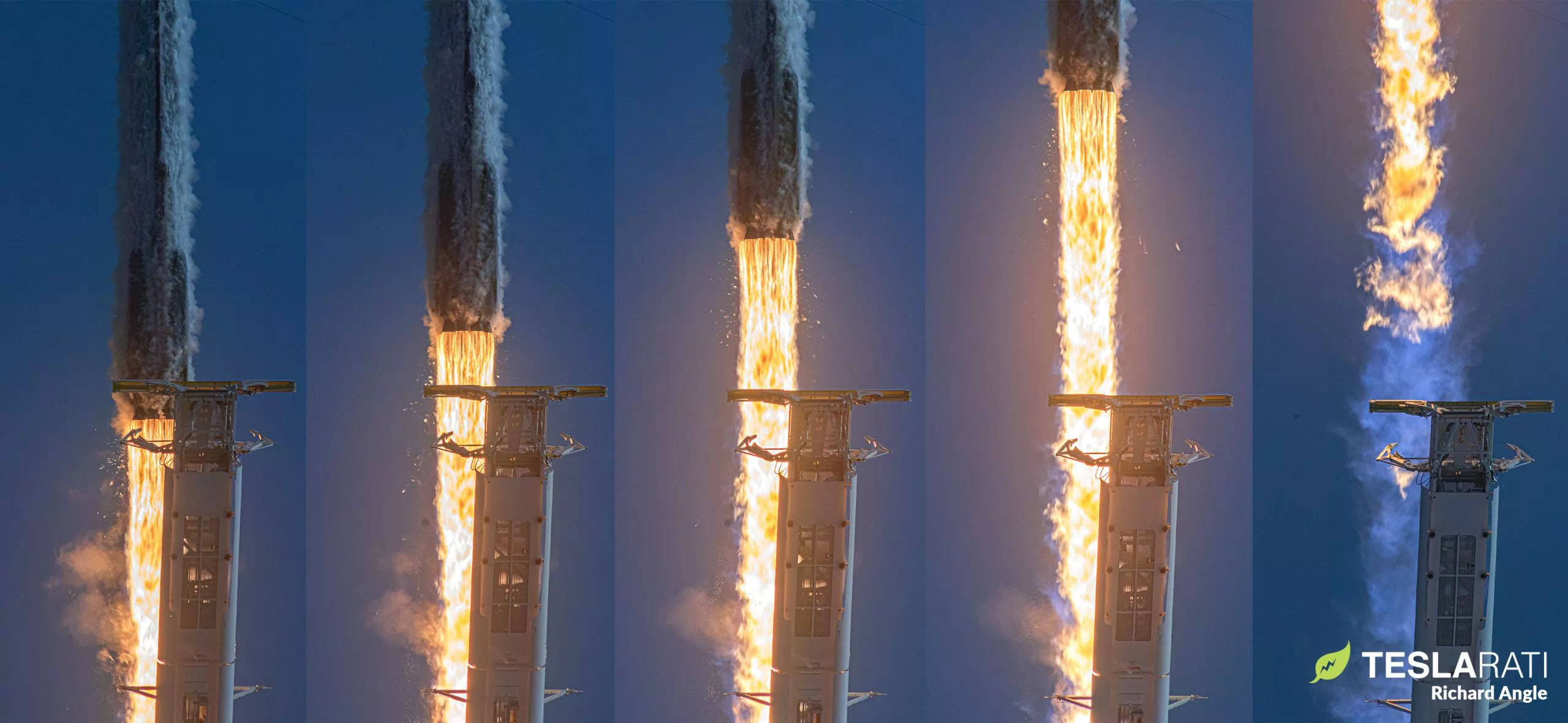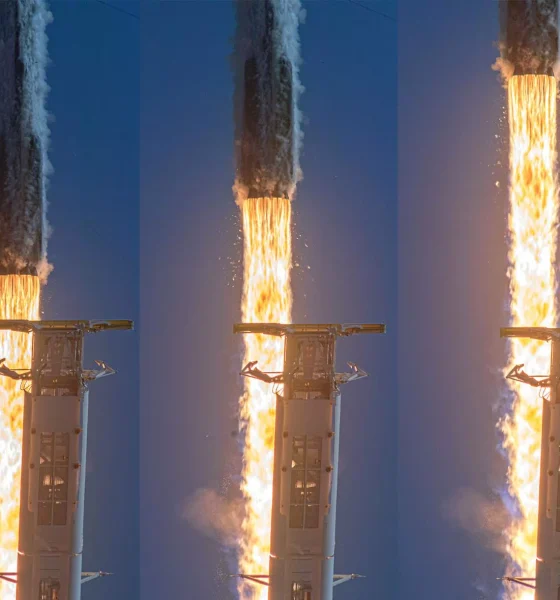

News
SpaceX settles on Thursday for first Falcon 9 launch of 2021
After a few days of delays, SpaceX appears to have settled on Thursday, January 7th for the first of several dozen Falcon 9 launches planned in 2021.
Originally scheduled to launch as early as January 4th, SpaceX’s Turksat 5A communications satellite launch was “placed TBD due to mission assurance” on January 1st – an unfortunate catch-all euphemism often used by launch providers in lieu of any real explanation for delays. Regardless, Next Spaceflight reports that Turksat 5A will be Falcon 9 B1060’s fourth launch, a milestone the first stage (booster) has reached just six months after its first flight.
Despite the minor delay, SpaceX’s current target of four launches this month is still well within reach even though the slip exemplifies the uphill battle the company will face as it aims to achieve CEO Elon Musk’s goal of 48 launches in 2021. Weather is currently 60% favorable for SpaceX’s first launch of the year and Turksat 5A is scheduled to lift off no earlier than 8:28 pm EST on January 7th (01:28 UTC, 8 Jan).
Good timing, too — the 45th said SpaceX’s next launch of Turksat was “placed TBD due to mission assurance.”— Emre Kelly (@EmreKelly) January 1, 2021
New forecast (60% favorable) and hazard area: pic.twitter.com/cEapdSd2DP— Emre Kelly (@EmreKelly) January 5, 2021
Unfortunately, SpaceX’s first launch of the new year has been steeped in unprecedented controversy for the company, including the first-ever instance of mass-protests at its Hawthorne, California factory and headquarters. The reason: Turksat 5A, while partially meant for civilian communications, will also support the Turkish military, which supported Azerbaijan after the country – unprovoked – reignited a long-simmering conflict in the Nagorno-Karabakh region in September 2020.
Stemming from events that transpired over the last several centuries, Armenian-Azeri conflict and Turkish involvement are extraordinarily complex and messy. In the 1910s and 1920s, Turkey (then the Ottoman Empire) infamously committed atrocities against Armenian, Assyrian, and Greek communities within its occupied territory in a process of “Turkification”, systematically killing 1-3 million people in what would ultimately be labeled genocide. In a separate but related conflict, Turkey eventually chose to support Azerbaijan’s claim to the ethnically (75-90%) and historically Armenian territory, backing the country against Armenia in the first Nagorno-Karabakh War in the 1990s.
Azerbaijan reignited the conflict in 2020, resulting in the deaths of at least 6000 combatants and civilians on both sides and ultimately securing a substantial portion of Nagorno-Karabakh territory as part of a November 2020 ceasefire agreement. To an extent, Nagorno-Karabakh’s borders are now more or less back to where they were before the first war in the 1990s. While an avoidable loss of life is inherently deplorable, it’s extremely difficult to say whether Azerbaijan was justified but it and Turkey’s history of systematic and discriminatory hostility towards Armenians leaves little benefit of the doubt worth giving.
Ultimately, that cloud of ambiguity makes it hard to directly fault SpaceX for choosing to launch Turksat 5A or for its contracts to launch Turksat 5B and future domestically-built satellites. Additionally, if SpaceX should be criticized for willingly launching the satellite, Airbus – contracted by Turkey to build Turksat 5A – is at least as worthy of critique but has yet to be included at all in protest discourse despite the fact that Turkey’s production contract was publicly announced in 2017.
In the history of spaceflight, a satellite that is completed but never launches is all but unheard of, as the inherent bureaucratic and financial inertia behind a launch campaign mere months away from its scheduled liftoff is obviously immense. Even if SpaceX were to accept major financial penalties and back out of its contract, Arianespace, Roscosmos, or ULA would assuredly accept any replacement contract.
For protestors still set on making an impact, the shrewd move would be to redirect attention on future Turkish satellite projects like Turksat 5B, 6A, and beyond with the intention of killing contracts in the cradle – a far more tenable goal.
Stay tuned for more launch details as SpaceX nears its first mission of 2021.

News
Tesla FSD fleet is nearing 7 billion total miles, including 2.5 billion city miles
As can be seen on Tesla’s official FSD webpage, vehicles equipped with the system have now navigated over 6.99 billion miles.

Tesla’s Full Self-Driving (Supervised) fleet is closing in on almost 7 billion total miles driven, as per data posted by the company on its official FSD webpage.
These figures hint at the massive scale of data fueling Tesla’s rapid FSD improvements, which have been quite notable as of late.
FSD mileage milestones
As can be seen on Tesla’s official FSD webpage, vehicles equipped with the system have now navigated over 6.99 billion miles. Tesla owner and avid FSD tester Whole Mars Catalog also shared a screenshot indicating that from the nearly 7 billion miles traveled by the FSD fleet, more than 2.5 billion miles were driven inside cities.
City miles are particularly valuable for complex urban scenarios like unprotected turns, pedestrian interactions, and traffic lights. This is also the difference-maker for FSD, as only complex solutions, such as Waymo’s self-driving taxis, operate similarly on inner-city streets. And even then, incidents such as the San Francisco blackouts have proven challenging for sensor-rich vehicles like Waymos.
Tesla’s data edge
Tesla has a number of advantages in the autonomous vehicle sector, one of which is the size of its fleet and the number of vehicles training FSD on real-world roads. Tesla’s nearly 7 billion FSD miles then allow the company to roll out updates that make its vehicles behave like they are being driven by experienced drivers, even if they are operating on their own.
So notable are Tesla’s improvements to FSD that NVIDIA Director of Robotics Jim Fan, after experiencing FSD v14, noted that the system is the first AI that passes what he described as a “Physical Turing Test.”
“Despite knowing exactly how robot learning works, I still find it magical watching the steering wheel turn by itself. First it feels surreal, next it becomes routine. Then, like the smartphone, taking it away actively hurts. This is how humanity gets rewired and glued to god-like technologies,” Fan wrote in a post on X.
News
Tesla starts showing how FSD will change lives in Europe
Local officials tested the system on narrow country roads and were impressed by FSD’s smooth, human-like driving, with some calling the service a game-changer for everyday life in areas that are far from urban centers.

Tesla has launched Europe’s first public shuttle service using Full Self-Driving (Supervised) in the rural Eifelkreis Bitburg-Prüm region of Germany, demonstrating how the technology can restore independence and mobility for people who struggle with limited transport options.
Local officials tested the system on narrow country roads and were impressed by FSD’s smooth, human-like driving, with some calling the service a game-changer for everyday life in areas that are far from urban centers.
Officials see real impact on rural residents
Arzfeld Mayor Johannes Kuhl and District Administrator Andreas Kruppert personally tested the Tesla shuttle service. This allowed them to see just how well FSD navigated winding lanes and rural roads confidently. Kruppert said, “Autonomous driving sounds like science fiction to many, but we simply see here that it works totally well in rural regions too.” Kuhl, for his part, also noted that FSD “feels like a very experienced driver.”
The pilot complements the area’s “Citizen Bus” program, which provides on-demand rides for elderly residents who can no longer drive themselves. Tesla Europe shared a video of a demonstration of the service, highlighting how FSD gives people their freedom back, even in places where public transport is not as prevalent.
What the Ministry for Economic Affairs and Transport says
Rhineland-Palatinate’s Minister Daniela Schmitt supported the project, praising the collaboration that made this “first of its kind in Europe” possible. As per the ministry, the rural rollout for the service shows FSD’s potential beyond major cities, and it delivers tangible benefits like grocery runs, doctor visits, and social connections for isolated residents.
“Reliable and flexible mobility is especially vital in rural areas. With the launch of a shuttle service using self-driving vehicles (FSD supervised) by Tesla in the Eifelkreis Bitburg-Prüm, an innovative pilot project is now getting underway that complements local community bus services. It is the first project of its kind in Europe.
“The result is a real gain for rural mobility: greater accessibility, more flexibility and tangible benefits for everyday life. A strong signal for innovation, cooperation and future-oriented mobility beyond urban centers,” the ministry wrote in a LinkedIn post.
News
Tesla China quietly posts Robotaxi-related job listing
Tesla China is currently seeking a Low Voltage Electrical Engineer to work on circuit board design for the company’s autonomous vehicles.

Tesla has posted a new job listing in Shanghai explicitly tied to its Robotaxi program, fueling speculation that the company is preparing to launch its dedicated autonomous ride-hailing service in China.
As noted in the listing, Tesla China is currently seeking a Low Voltage Electrical Engineer to work on circuit board design for the company’s autonomous vehicles.
Robotaxi-specific role
The listing, which was shared on social media platform X by industry watcher @tslaming, suggested that Tesla China is looking to fill the role urgently. The job listing itself specifically mentions that the person hired for the role will be working on the Low Voltage Hardware team, which would design the circuit boards that would serve as the nervous system of the Robotaxi.
Key tasks for the role, as indicated in the job listing, include collaboration with PCB layout, firmware, mechanical, program management, and validation teams, among other responsibilities. The role is based in Shanghai.
China Robotaxi launch
China represents a massive potential market for robotaxis, with its dense urban centers and supportive policies in select cities. Tesla has limited permission to roll out FSD in the country, though despite this, its vehicles have been hailed as among the best in the market when it comes to autonomous features. So far, at least, it appears that China supports Tesla’s FSD and Robotaxi rollout.
This was hinted at in November, when Tesla brought the Cybercab to the 8th China International Import Expo (CIIE) in Shanghai, marking the first time that the autonomous two-seater was brought to the Asia-Pacific region. The vehicle, despite not having a release date in China, received a significant amount of interest among the event’s attendees.








